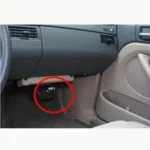OBD2 drivers are essential software components that bridge the gap between your OBD2 scanner and your computer, enabling you to access and interpret your vehicle’s diagnostic data. Without the correct OBD2 drivers, your scanner is just a piece of hardware. This comprehensive guide will delve into the world of OBD2 drivers, covering everything from their function and importance to troubleshooting and finding the right drivers for your specific needs.
What are OBD2 Drivers and Why Do You Need Them?
Imagine trying to understand a foreign language without a translator. That’s essentially what it’s like trying to use an OBD2 scanner without the correct drivers. The drivers act as the translator, converting the raw data from your vehicle’s onboard computer into a readable format that diagnostic software on your computer can understand. This allows you to identify and troubleshoot potential issues, monitor vehicle performance, and even customize certain settings. Whether you’re a professional mechanic or a DIY enthusiast, OBD2 drivers are crucial for unlocking the full potential of your diagnostic tools.
Finding the Right OBD2 Drivers for Your System
Choosing the right OBD2 drivers depends on several factors, including your operating system (Windows, macOS, Linux), the type of OBD2 scanner you’re using (Bluetooth, USB, Wi-Fi), and the specific make and model of your vehicle. It’s important to download drivers from reputable sources to avoid malware and ensure compatibility. Many manufacturers provide drivers on their websites, or you can find them on trusted third-party platforms. For users of older operating systems, check out our guides on obd2 drivers windows xp and obd2 drivers windows 7 download. For more modern systems, we also have resources for obd2 drivers windows 10.
Where Can I Download OBD2 Drivers?
- Manufacturer’s Website: This is the most reliable source for drivers.
- Trusted Third-Party Platforms: Ensure the platform has a good reputation.
- OBDFree.com: We provide resources and links to help you find the right drivers.
Troubleshooting Common OBD2 Driver Issues
Sometimes, even with the correct drivers installed, you might encounter issues. Here are some common problems and solutions:
- “Device Not Recognized” Error: Try a different USB port or cable. Reinstall the drivers or try a different version.
- Connection Issues: Ensure your OBD2 scanner is properly connected to both your vehicle and your computer. Check for Bluetooth or Wi-Fi connectivity problems. If you’re using an OHP scanner, you may need to consult our guide on ohp obd2 drivers.
- Software Compatibility: Make sure your diagnostic software is compatible with your OBD2 scanner and drivers.
“Ensuring your OBD2 drivers are up-to-date is like giving your diagnostic toolkit a regular tune-up,” says Michael Davies, Senior Automotive Diagnostic Technician at Apex Auto Solutions. “It ensures smooth communication between your scanner and software, leading to accurate readings and efficient troubleshooting.”
USB OBD2 Drivers: A Focus on Connectivity
USB OBD2 drivers are commonly used for their plug-and-play convenience. usb obd2 drivers are generally straightforward to install. Simply connect your scanner to your computer’s USB port and follow the on-screen instructions. However, ensure you’re using a compatible cable and that your computer’s USB port is functioning correctly.
Conclusion: The Importance of Keeping Your OBD2 Drivers Updated
OBD2 drivers are the unsung heroes of vehicle diagnostics. Keeping them updated ensures accurate readings, efficient troubleshooting, and unlocks the full potential of your OBD2 scanner. Whether you’re a professional or a DIYer, understanding and managing your OBD2 drivers is essential for anyone working with vehicle diagnostics.
“Regularly checking for driver updates can prevent compatibility issues and ensure you’re getting the most out of your diagnostic software,” adds Sarah Chen, Lead Software Engineer at AutoDiagTech. It’s a simple step that can save you time and frustration in the long run.
Need further assistance? Contact us via WhatsApp: +1(641)206-8880, Email: [email protected] or visit our office at 789 Elm Street, San Francisco, CA 94102, USA. Our 24/7 customer support team is always ready to help.
